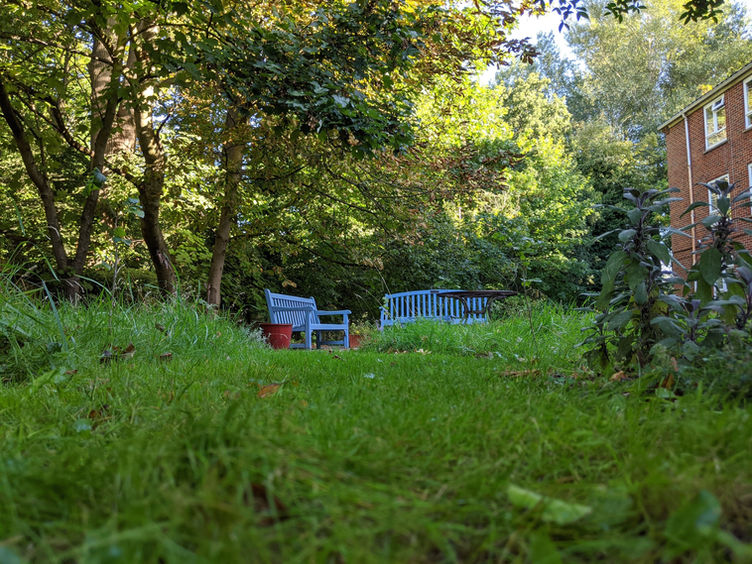Dementia Garden, Newbury
This garden was a low-budget, low-maintenance creation for a specialist dementia home. Areas of edible planting, wheelchair accessible raised beds and seating areas are linked by reinforced grass mats.
The layout consists of smaller loops and a larger figure of eight route which enables and encourages wandering through the garden, reducing chance of confusion and increasing independence in the space. The paths are zimmer-frame and wheelchair friendly, and also provide a safer CFH (critical fall height) than traditional, more expensive path options. The grass grows through the matting, offering year-round use, and the immersion of being amongst more greenery, but safely. They also increase the 'green to grey' ratio, grey being hard landscaped areas, such as patios. Having a high green to grey ratio plays an important role in the healing nature of outdoor spaces.
The two reclaimed timber raised beds are built with space underneath such that they are suitable for both wheelchair and standing access. Planted within the beds are three patches of different, carpeting low-growing scented plants that when touched release a scent, including a Causican Mint, Creeping Thyme and Chamomile. Apart from these plants the beds are un-planted, offering a designated and manageable zone for the staff and residents to plant annual veg and bedding plants in.
Included throughout and also planted at specific points is planting for sensory stimulation. For example the Grapefruit Mint bed, on a corner path and placed opposite a seating area. This gives the opportunity for staff and residents to brush past the mint releasing its scent but also to engage in activities such as 'guess the herb' and making mint tea.
All the planting is low maintenance non-toxic and mainly consists of edible perennial plants with the exception of a couple of varieties, chosen for their value as cut flowers, to be brought into the home for so those who are inside can gain value from the garden. Wild Strawberries offer a low growing berry producing ground cover, suppressing weeds in the process.
Part of the low-maintenance design is provided by spreading a locally sourced organic mulch over the flower beds which improves the soil, reduces weeds and retains moisture thus reducing the need for watering.
A trained Oregan Thornless Blackbery, chosen for its taste and ornamental leaf shape, offers both beauty and stimulation from both picking the fruits and eating them. Giant Daisies growing to waist height offer the opportunity for cut flowers and daisy chain making, and being large daisies they are more workable for less able hands and offer an opportunity for reminiscence.
A lot of the design considerations are based around increasing engagement in the garden and therefore often physical activity and time spent outdoors, which has numerous proven benefits from better sleep habits to increased recovery time from illnesses. These include a washing line complete with two lines, one for wheelchair access and another for standing, a basket full of 'washing' and pegs. The placement in the garden gives the residents the opportunity to start hanging out/bringing in the washing at their convenience, giving an opportunity for a reminiscent activity as well as engagement in exercise.














